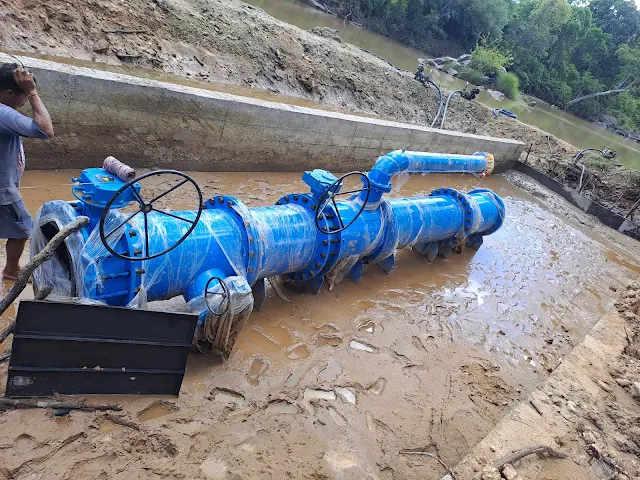
Punit Singh, Associate Professor at the Centre for Sustainable Technologies (CST), Indian Institute of Science (IISc), has been working on a solution to address the problem of irrigation scarcity for the past 10 years in Chhattisgarh.
Prof. Singh developed this zero-electricity water pumping solution using low-head check dams and cascades of such dams along rivers, with turbine pumps installed to pump water without any electricity.
The novelty lies in the precise design of the system.
Chhattisgarh receives river water supply from the Ganga, Godavari, and Mahanadi basins. While canal networks have been developed to cover a substantial portion of the region north of Raipur, a large part of the tribal-majority areas in southern Chhattisgarh lack reservoir-based irrigation. Many farmers in the region primarily rely on Kharif-based (monsoon) crop yields. Alternative methods like pipe-based irrigation have been explored but have not gained popularity or acceptance.
Prof. Singh’s efforts started with a field survey to understand the soil and terrain of Taipadar village in Bastar district. Due to his efforts, Taipadar has now been equipped with this zero-elecricity water pumping system.
 |
The turbine uses about 90% of the river water flow at low head (which is then recycled back to the river) to generate power, specifically torque and speed, which is then used to drive standard submersible multi-stage pumps. The novelty lies in the precise design of the system. Depending on specific site conditions, where the water head ranges from 2-4 metres, the objective is to lift and transport water to different elevations, usually between 15 and 25 metres, or even up to 30 metres as required.
 |
 |
Prof. Singh started working on developing turbine pumps for electricity generation during his PhD at the Karlsruhe Institute of Technology, Germany. When he returned to India in 2009, he started exploring the deployment of ram pumps in Chhattisgarh, starting with Taipadar. “Two turbine pumps with power generation capabilities were generously sponsored by the KSB Pumps Trust in Germany. I invested about Rs 50 lakh in the ram pump sourced from Rife, USA, and in the construction work which spanned three years,” Singh says. Apart from Taipadar, similar systems were also set up in Girdalpara in the Sukma district and Karhani in the Gourella-Pendra-Marwahi (GPM) district, the impact of which is visible in the field, adds Prof. Singh.
In December 2022, the Foundation for Science Innovation and Development (FSID) at IISc joined hands with the Chhattisgarh Water Resources Department (WRD) to scale up the water resource management and irrigation infrastructure in Chhattisgarh. The areas covered under this collaboration include Karhani, Neelawaram (Sukma district), and Pongro (Jashpur district).
“This collaboration supports the project at large. For instance, the responsibility of site work, civil works, and delegating logistical implementation of the turbine will be handled by the state. So, IISc can focus on designing the turbine, and ensuring the proper working of the turbine at the site. The other support is that now we can procure funds and allocate that to vendors,” adds Prof. Singh.
Under the collaboration, IISc will test the quality of turbines manufactured by various vendors at a designated simulation facility.
Vikram Jayaram, Professor at the Department of Materials Engineering, IISc, says, “This partnership [with the government officials] eases the administrative process behind irrigation projects. As we get the funds from the government, we can distribute the funds to our partners providing the services. Moreover, IISc’s role includes inviting the irrigation engineers to witness the tests and providing essential training. These engineers will further train a local resource person at the specific project site.”
The other people involved in this project include B Gurumoorthy (Chief Executive, FSID) as well as officials from Chhattisgarh, including Anbalagan P, Water Resources Secretary (IAS); Richa Prakash Choudhary, Collector (IAS); Ajay Somawar, Chief Engineer; and Madhuchandra, Executive Engineer.
Over the next few years, the collaboration will focus on installing one or two pumps on each dam, along with piping, storage, and canal networks. “Building 25 per year is the first target and then based on the success, it could be scaled up to all the 400 or more dams,” Prof. Singh says. Each project will irrigate about 100-150 acres for rabi and summer crops depending on the conditions and design of the turbine and pumps. “The greatest benefit is that this will free the farmers near the banks from using groundwater, allowing levels to rise,” adds Prof. Singh. “This technology is capable of being reproduced in large parts of India that offer perennial water flow.”
Source — IISc
















 IndianWeb2.com is an independent digital media platform for business, entrepreneurship, science, technology, startups, gadgets and climate change news & reviews.
IndianWeb2.com is an independent digital media platform for business, entrepreneurship, science, technology, startups, gadgets and climate change news & reviews.



